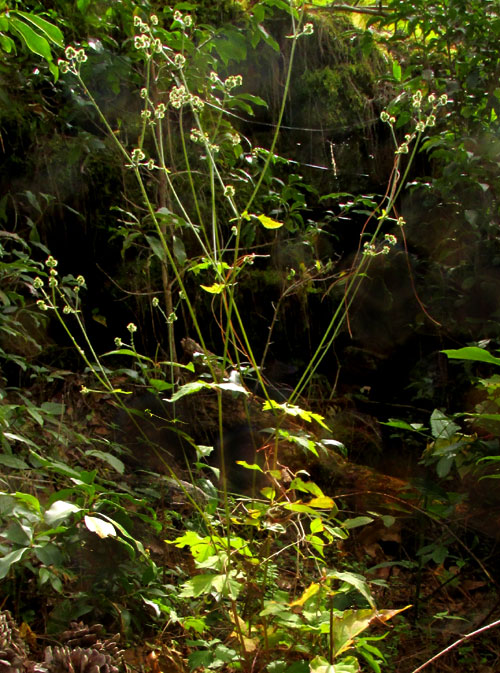Excerpts from Jim Conrad's
Naturalist Newsletter
entry from field notes dated January 19, 2023, taken along steep, one-lane gravel road ascending forested, northeast-facing mountain slope, elevation ±2,380m (7600 ft); bedrock of Cretaceous limestone; on the south side of Pinal de Amoles, Querétaro state, MÉXICO, (N21.134°, W99.629°)
SNAKEROOT

Along the steep trail up the mountain the above hip-high herb caught my eye because it looked like several species of common wildflowers in the forests of North America, called snakeroots, genus, Sanicula. Those pea-sized, round flowering heads at the plant's top, diffusely dispersed on stiff, slender, forking and re-forking stems, with sparse herbage except at the base, are very distinctive.  The leaves are palmately compound, the conspicuously toothed leaflets arising from a common point atop the petiole, like fingers from a hand's palm. As shown at the right, the burry flowering heads are even more unique.
The leaves are palmately compound, the conspicuously toothed leaflets arising from a common point atop the petiole, like fingers from a hand's palm. As shown at the right, the burry flowering heads are even more unique.
Snakeroots are members of the big Parsley/Carrot family, the Apiaceae. In that family, species often are aromatic and normally have their blossoms arranged in umbel-type flower clusters. Snakeroots aren't aromatic and their inflorescences aren't obviously umbellate, umbels being flower clusters in which the flower stalks, or pedicels, are of nearly equal length, uniting at their bases, and with the flowers forming a flat or curved surface.

At the left, a close look at one of the pea-shaped heads shows that it's composed of two types of flower. The burry items with white, hooked trichomes are flowers bearing both male and female parts, with the burs covering the blossoms' inferior ovaries, the future fruits. Later the hooked spines will enlarge and harden, and latch onto passing mammals, who will carry the fruits into new locations. Among the burry-bottomed bisexual flowers appear other flowers atop slender pedicels and bearing five yellowish petals and pollen-producing stamens, but no female parts.
Immediately recognizing our plant as a snakeroot species, it was easy to figure out this species, since only one species of the genus Sanicula is documented for Querétaro state. That's SANICULA LIBERTA, found in highland forests throughout upland Mexico south through Central America into northwestern South America, and following the Andes well south, perhaps into Chile.
Our plant almost became known as Sanicula mexicana, because it was collected and introduced to science under that name when the French-Mexican naturalist, physician and anthropologist Jean-Louis Berlandier collected it in Hidalgo state in 1827, after which the name was published by the Swiss botanist Augustin Pyramus de Candolle as Sanicula mexicana. However, a year before Berlandier found it, the German Alexander von Humboldt and French Aimé Bonpland had collected the same species in Venezuela. The name Sanicula liberta was published for it in 1826, earlier than the publication of the S. mexicana name. Therefore, Sanicula liberta has precedence, and the name Sanicula mexicana sinks into oblivion.
The genus name Sanicula derives from the Latin sanus, meaning "healthy," reflecting the use of Europe's snakeroot, Sanicula europaea, in traditional herbal medicine. The English name snakeroot is applied to various plant taxa, not only species of the genus Sanicula, used traditionally against snakebite.
Curiously, Spanish speakers don't appear to consider our snakeroot medicinal, or for much good of any kind. Botanists list its presence here and there, and supposedly the occasional herbivore swallows a little, but otherwise it's an ignored presence in Mexico.